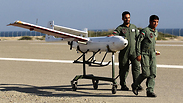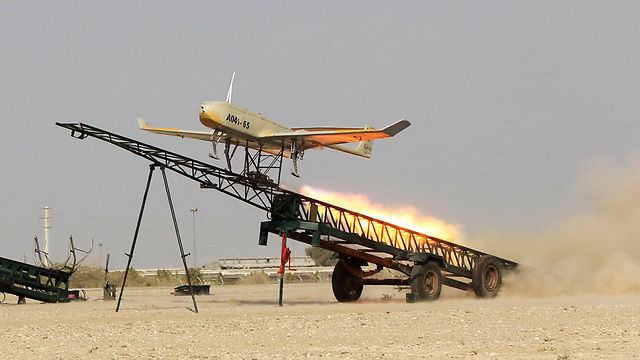Iran's "suicide drone" is not a technological breakthrough. It's a relatively large unmanned plane meant to carry a large amount of explosives over relatively short distances and crash into large targets, blowing them up. The interesting thing is that this drone was first announced during a massive military drill by land forces near the Strait of Hormuz.
The Iranians' purpose in the announcement was two-fold: To demonstrate to the Iranian people the military technology being developed, but mainly to show the US and the oil-exporting Arab nations that Iran has the power to close the Strait of Hormuz.
The drone is not intended to hit surface-to-air missile batteries like Israel's "Harpy" drone, but merely to blast into American aircraft carriers, oil tankers, and perhaps even oil wells. The camera carried by the drone is meant only to identify the target and ensure that its handlers on the ground can direct its course.
Despite the lack of sophistication, this drone could cause serious damage to oil tankers and other civilian targets because it carries a large amount of explosives. That said, the American carriers have warning and offensive capabilities and could blow such a drone out of the sky.
Its construction suggests that it is not particularly fast, and could not carry a large enough amount of fuel to allow it to reach distant targets. If the drone is supplied to Hezbollah or Hamas, it will present a problem, because it could then hit gas fields in the Mediterranean or large targets near the Israel-Gaza barrier.
But the drone's most major liability is that it is slow and large, making it relatively easy to intercept from air or sea.
The drone was unveiled during a six-day military exercise by Iran being carried out over 527,000 square kilometers (850,000 square miles) in the northern part of the Indian Ocean, Sea of Oman and the eastern part of the Persian Gulf, through which one-fifth of the world's oil supply passes.
The exercise, dubbed Mohammad Rasoulallah (Mohammad, the Messenger of God) involved all branches of the Iranian military and will last for six days, spanning 2.2 million square kilometers, Iranian news television Press TV reported.
General Hashma Allah Malka said it was an "Important message of peace to our friendly neighbors, but also a show of force regarding our defense abilities which sends a message to our enemies."
As part of what Iranian media are calling a massive show of force, the army will maneuver from the Strait of Hormuz in the Persian Gulf all the way to the Gulf of Aden and even the parts of the Indian ocean. According to different reports, the Iranian Navy will be testing warships and submarines.
Iran's navy has boosted its international presence over the past few years, in particular to help guard commercial vessels in the Gulf of Aden from pirate attacks.


















